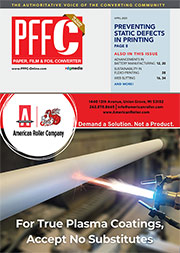Featured Stories
-
Nordson Divisions Collaborate to Achieve Unprecedented Flat Profile Time
Nordson Measurement & Control Solutions (a division of Nordson Corporation) is a global leading provider of gauging systems for the film... -
Preventing Static Defects in Digital Printing
Digital printing has revolutionized document creation. -
Choosing the Right Flexible Packaging Pouching Supplier
Wish you had more production capability to fulfill pouching jobs or maybe you are looking for a backup when your equipment goes down?
News | New Products
-
FLAG Announces April Lunch & Learn Event: Variable Data Printing in Labels & Preparing for the Sunrise 2027
Flexo Label Advantage Group LLC (FLAG) announced its upcoming April 2025 Lunch & Learn, taking place Thursday, April 17 at 2:00 PM EST.
-
CT Manufacturer Leads Global Green Packaging Industry
Strong, Sustainable Products Protect Human Lives And the Environment From Toxic Lithium Battery Fires
-
Rolling Start: Beontag and Kumho Tire Announce Partnership to Produce RFID-enabled Tires for Consumer, Commercial Vehicles
Beontag, one of the world’s largest manufacturers of self-adhesives and smart tags such as RFID
-
Unlocking Growth and Sustainability: How Packaging Powers Circularity for Consumer Packaged Goods Companies
Original research in a new white paper from Avery Dennison explores how innovative pressure-sensitive labels help enable packaging circularity throughout the value chain
-
Avery Dennison Names Senior Vice President and General Manager for Materials Group North America
Avery Dennison has named Anil Sharma as senior vice president and general manager for Materials Group, North America.
-
Esko – Mark Andy Innovation Day
How to optimize and increase label production efficiency
-
Now among the top 5 percent in terms of sustainability: Gold Medal for HERMA from EcoVadis for First Time
Following two silver medals in previous years, HERMA was able to achieve a gold medal for the first time in the EcoVadis sustainability audit.
Expert Advice
Deciphering the complexities of the core/shaft/unwind relationship.
- Published: February 01, 1996, By Boyle, Edward
When designing a core/shaft/unwind system for a particular application, there are many factors to consider. What are these considerations, and how do you get past them to start rolling out quality product?
In examining the relationship among cores, shafts, and unwinds, what are the most important factors to consider? First and foremost, says William R. Myer, president of Geometric Machine and Design, is the material composition of the core itself, followed closely by the choice between shaft or shaftless unwinds.
In addition, there are two types of shafts - mechanical and pneumatic - and two types of core chucks for shaftless operation, again, mechanical and pneumatic.
Suitability of Core Materials
There are many types of core materials to consider. Certainly, says Myer, the "cardboard" (or fiber) core is the most popular, but there are also reinforced plastic cores, "standard" plastic cores, and metal cores. Composition of reinforced plastic cores can be linen-based phenolic, fiberglass-based epoxy, or polyester resins. Plastic cores can be comprised of polyvinyl chloride (PVC) or nylon. Metal cores can be either steel or aluminum.
"Each of the different materials possesses different problems with the shafts and chucks," says Myer, "with the primary problem being the ability to grip the core material." Additionally, fiber cores need to be strong enough to transmit the torque required to maintain tension control without crumbling.
When examining the variety of shafts and chucks available, there are "many, many" considerations that must be given to the unwind core and chucks because of the vast amount of options available to the designer, says Myer. Chuck and shaft manufacturers have specific recommendations for gripping cores. They typically also can supply torque capacity charts for the different shafts and chucks.
A different problem is posed by mechanical chucks, according to Myer. Eccentric-type mechanical chucks need enough friction to be able to grab the core material. They also need to be under tension in order to grip properly. These chucks usually have a specific torque range within which they work well for different core materials. However, they are not as forgiving as the tapered mechanical type utilized in power chucking that are forced into the core. This chuck has an "incline" designed inside so that, as it is forced into the core, the chuck itself slides up the incline, and the lugs inside the chuck are forced out into the core, thus gripping the core.
"These chucks work excellently with fiber cores and transmit tremendous amounts of torque," explains Myer. "However, with heavy-duty plastic and metal cores, there is frequently a problem with jamming. Pneumatic chucks and shafts work very well with the heavy-duty plastic and metal cores used with most unwind applications."
Importance of Selection & Ergonomics
Considerable thought must also be given not only to the core but also the shaft when designing for unwind applications, Myer says. There are many different types of shafts, including small button, large button, lug-type, and leaf shafts. The same holds true for chucks; there are bladder-type chucks, leaf-type chucks, and lug chucks.
"They all have their pros and cons," says Myer. "Generally, for a machine to be versatile, compromises must be made when picking chucks or shafts for applications."
Another area for consideration is ergonomics. Certainly the new lightweight carbon shafts now available minimize operator back problems, Myer points out. An increasingly popular option is the selection of shaftless unwinds, employing chucks instead, that reduce shaft handling and increase productivity. There are some applications, however, in which chucks cannot be utilized, and it is absolutely necessary, says Myer, that a shaft is used. On wider machines, composite shafts seem most popular.
When choosing shafts, leaf shafts can utilize knurled leafs, smooth leafs, or rubber leafs. Also, button shafts can utilize plastic buttons, rubber buttons, steel buttons, brass buttons, and more. The same holds true for lug shafts and different types of chucks. The different types of materials utilized in lugs and buttons accomplish different things, typically transmission of torque, depending on the core material.
Different types of lugs and buttons may work better to transmit torque for the tension requirements. Also, the number of lugs and buttons can be increased or decreased for torque transmission.
"Considerable work has been done in the area of hybrid materials for the lugs and buttons to accommodate the different core materials," says Myer. "The shaft manufacturer or the machinery manufacturer should definitely be consulted to make sure the proper material and the configuration of the chuck or shaft is the best combination for the application."
Core Size a Factor
Yet another area of consideration noted by Myer is the different size cores that are being utilized today. Machines with just-in-time production schedules are required to be more versatile and to run a wider variety of different materials in smaller quantities with increased productivity and reduced downtime. To maximize this effort, many different types of core chuck and shaft systems are being configured.
"There are on the market today mechanical and pneumatic core chucks that can be utilized in the shaftless configuration," notes Myer, "with slip-on units to increase diameter without removal of the chuck."
For increased productivity during size changes, stub shafts can be utilized in the ends of the cores that are available in different diameters to facilitate fast size changes, Myer says. This utilizes the strength of the unwinding roll itself, in the same manner as a shaftless operation.
He adds, "Of course, when you go to a shaftless operation, loading of the rolls onto the machine becomes a consideration, because there is no extended shaft for hoist loading."
In most cases, hydraulic list tables are provided. In addition, hydraulic arms on unwind stands can be moved down to lift the roll after chucking to facilitate unwinding. Turret unwinds have been developed with shaft loading incorporated into the design of the turret. As the turret rotates, Myer explains, the shaft is picked up with straps or cables and loaded into the unwind position.
"All of these items certainly affect the relationship among cores, shafts, and unwinds," Myer concludes. "And all must be considered when designing a system for a particular application. Considering the complexity, it is very important for the end user to utilize the talents of the machine manufacturer in this area."




















